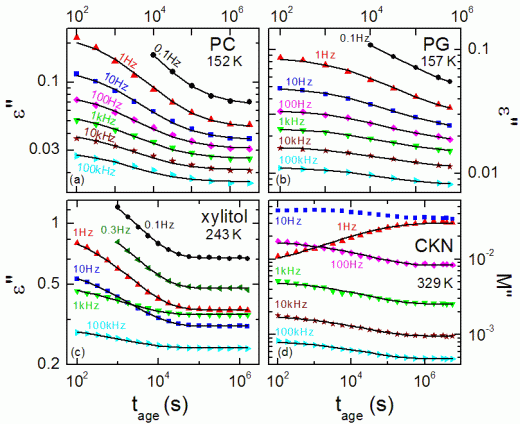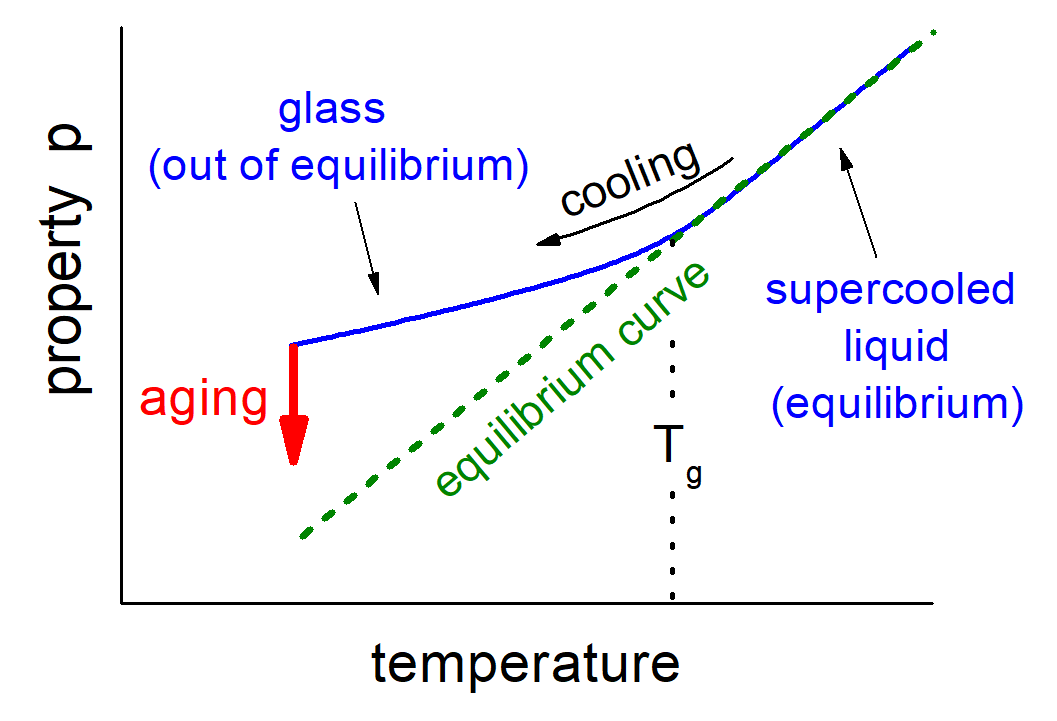GLASSY AGING DYNAMICS
1. Introduction
When a
glassforming liquid
is cooled fast enough, below its glass temperature Tg it
becomes a glass - a "frozen liquid" - that is out of thermodynamic equilibrium.
Keeping then the glass at a constant temperature, the so-called "physical aging"
takes place, i.e. its physical properties vary with
time when the material tries to regain the equilibrium state. This is of
considerable technical importance in glass fabrication and for the
degradation of glassy materials in applications as glass fibers, optical
components or polymers.
2. Examples:
We have performed aging experiments, measuring time-dependent
dielectric properties
in a large variety of different glass formers [3-6]. We showed that the
aging of glasses can be described much simpler than by the many-decades
old models used so far. We found that the time characterizing the
rapidity of the aging is identical to the time characterizing the
microscopic molecular motions (the "α relaxation") and that
this time itself varies with
time during aging. We found a self-consistent recursive formula
to describe the time-dependence of the physical properties of the glass,
which is straightforward to apply and involves less parameters than the
models used so far by glass physicists and engineers [3,6] (see Figure).
Overall, the aging of glasses is governed by the same mechanisms
as the dynamic equilibrium properties of the corresponding liquids.

|
Time dependence of dielectric loss (a-c) or modulus (d) at various
frequencies for four glassformers after quickly cooling from the liquid
into the glassy state. The lines are fits with the new approach. For each
material, the main fit parameters are the same for all frequencies and fully
consistent with the results at temperatures above the glass transition.
[P. Lunkenheimer, R. Wehn, U. Schneider, and A. Loidl,
Glassy aging dynamics,
Phys. Rev. Lett. 95, 055702 (2005).]
|
In addition, we have performed time-dependent measurements of the
excess-wing
region, showing up in the broadband dielectric spectra of many glassforming liquids as a second power law at the
high-frequency flank of the α-peak [1,2]. Its physical origin is a long-standing riddle of glass
physics. Applying maximum aging times of up to five weeks, at temperatures below the glass
temperature the excess wing develops into a shoulder. These results clearly indicate that the
excess wing is due to a secondary relaxation process. Click
here
to learn more.
3. Some relevant publications from our group:
| [1] |
Excess wing in the dielectric loss of glass formers: A Johari-Goldstein β relaxation?
U. Schneider, R. Brand, P. Lunkenheimer, and A. Loidl,
Phys. Rev. Lett. 84, 5560 (2000).
[PDF (copyright 2000 by the American Physical Society)]
|
| [2] |
Excess wing in the dielectric loss of glass formers: Further evidence for a β-relaxation
P. Lunkenheimer, R. Wehn, Th. Riegger, and A. Loidl,
J. Non-Cryst. Solids. 307-310, 336
(2002). |
| [3] |
Glassy aging dynamics
P. Lunkenheimer, R. Wehn, U. Schneider, and A. Loidl,
Phys. Rev. Lett. 95, 055702 (2005).
[PDF (copyright 2005 by the American Physical Society)]
|
| [4] |
Dielectric spectroscopy on aging glasses
P. Lunkenheimer, R. Wehn, and A. Loidl,
J. Non-Cryst. Solids 352, 4941 (2006). |
| [5] |
Broadband dielectric spectroscopy and aging of glass formers
R. Wehn, P. Lunkenheimer, and A. Loidl,
J. Non-Cryst. Solids 353, 3862 (2007). |
| [6] |
On the derivation of equilibrium relaxation times from aging experiments
R. Richert, P. Lunkenheimer, S. Kastner, and A. Loidl,
J. Phys. Chem. B 117, 12689 (2013). |
Homepage P. Lunkenheimer

